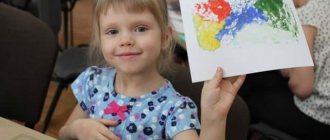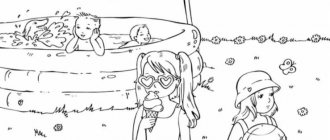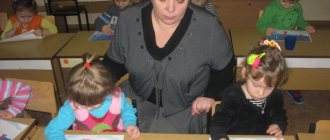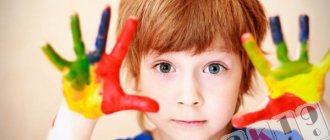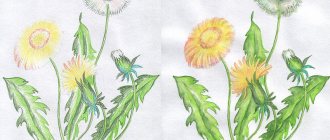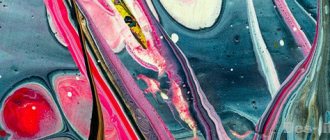Consultation on the topic “Non-traditional drawing techniques with young children”
Consultation on the topic
“Non-traditional drawing techniques with young children”
Preschool childhood is a very important period in the life of children. It is at this age that every child is a little explorer, discovering the unfamiliar and amazing world around him with joy and surprise.
I draw - my hands are covered in paint, this is a small thing for me, I paint with bright paint, he will look at me. In kindergarten we paint ears, noses and eyes. We get little faces and messy children.
Unconventional drawing with young children
Preschool childhood is a very important period in the life of children. It is at this age that every child is a little explorer, discovering the unfamiliar and amazing world around him with joy and surprise. The more diverse children's activities are, the more successful the child's diversified development is, his potential capabilities and first manifestations of creativity are realized. That is why one of the closest and most accessible types of work with children in kindergarten is visual, artistic and productive activity, which creates conditions for involving the child in his own creativity, in the process of which something beautiful and unusual is created.
Non-traditional drawing technique is a new direction in art that helps to develop a child comprehensively. Non-traditional drawing techniques when working with children contribute to the development of children's artistic talent.
The ability to draw appears in children at an early age, when they draw with their fingers on foggy glass or with chalk on wallpaper. As many adults know, conscious movements of the fingers lead to the activation of speech activity. The more we devote
attention to this, the faster the process of speech production will go. In the process of drawing, a child experiences various feelings: he is happy about the beautiful image that he himself creates, and he is upset if something doesn’t work out. By connecting and combining simple elements, our kids develop imagination, spatial and imaginative thinking. When using non-traditional drawing techniques, both hands work, and this allows for excellent coordination. And never say that it turned out badly, because our children need confidence in their abilities. For a child, creativity is a process, not a result.
While drawing, I came across the fact that kids are afraid to draw. They feel like they can’t do anything, that they don’t know how to draw, or that they just don’t want to get their hands dirty. But over time, looking at their peers, they slowly became involved in the process so that sometimes it was impossible to tear them away from their activities. I started my work with the simplest techniques of non-traditional drawing: drawing with cotton swabs, stamps, foam rubber, glue brush, only then I added drawing with fingers and palms. After all, not all children can immediately dip their finger into a jar of paint or completely lower their palm into a plate with the same paint. But before you start drawing directly, you need to get the child interested in it. Therefore, when teaching young children, I used games, poems, nursery rhymes, riddles, played out the plot of the future drawing with the help of various toys, objects, pictures; used finger and movement games and musical works. The children quickly became interested in the process, and it was possible to hold their attention longer, as well as set them up for a positive motive for the activity.
Unconventional ways of drawing with young children
Article “Unconventional methods of drawing with young children: pros and cons.”
Author: Galina Yuryevna Eryshova, teacher of the MBDOU “Kindergarten No. 32” in the city of Arzamas, Nizhny Novgorod region. Description of the material: this material will be useful to educators, additional education teachers and all those who are concerned about the problem of visual activity of younger preschoolers. Goal: increasing psychological and pedagogical competence on the issue of organizing visual activities with young children using non-traditional drawing methods. One of the priority areas ensuring the development of the abilities and creative potential of each child in the Federal State General Education Standards of Preschool Education is the artistic and aesthetic development of preschoolers. Currently, the problem of visual activity is of particular relevance, as it contributes to the perception and emotional response of children to beauty in the world around them - nature, human relationships, in the world of things. The formation of prerequisites for the perception and understanding of the natural world, the formation of an aesthetic attitude towards the surrounding world begins from a very early age. It is during this period that the child’s connection with the world of people, nature, and the objective world is established, he is introduced to universal human values, curiosity develops, and an interest in creativity is formed. The problem of visual activity of children in kindergarten was once dealt with by N.P. Sakulina, N.B. Khalezov, a number of researchers led by N.A. Vetlugina (T.G. Kazakova, V.A. Ezikeeva - in the field of drawing), A.V. Bakushinsky, D.B. Bogoyavlenskaya, A.A. Wenger. The authors studied children's creativity in general, its originality, developmental features, ways and methods of influencing children. Unconventional drawing techniques are interestingly presented in the works of G.N. Davydova, D.N. Koldina and others. • “To receive the beginning of aesthetic education in childhood means to acquire a sense of beauty for the rest of your life, the ability to understand and appreciate works of art, and to become involved in artistic creativity.” (N.A. Vetlugina). • “Fine art is the first, most accessible and attractive form of creative work for children.” (L.S. Vygotsky). • “It is necessary and possible to search for ways of interaction that, on the one hand, preserve the advantage of children’s creativity, and on the other hand, will help the child master the means of self-expression.” (N.P. Sakulina). Young children are constantly in a state of exploring the world around them. It is very important to teach beauty from a very early age. And what could be a more clear example for understanding beauty than fine art? Drawing for a child is a joyful, inspired work, to which he should not be forced, but it is very important to stimulate and support the child, gradually opening up new possibilities for visual activity. A peculiarity of teaching fine arts is that two main approaches , which can be defined as academic teaching and free education. In the first case, children are taught to depict objects in accordance with the requirements of realistic fine art. With such a system of education, children can acquire some skills that are useful in many specialties and everyday situations, but they do not gain experience in solving artistic problems and do not become familiar with art. This is learning without creativity. In the second case, a favorable environment and conditions for creativity are created for children without providing targeted pedagogical influence. They gain the experience of free self-expression, communication with artistic materials, etc. But this is creativity without learning. It rises on the wave of “age-related talent,” as if apart from the child himself, and with it fades away. The little artist does not “take control” of his own creative potential. A third way is needed —the path of purposeful guidance of children’s creative development. The first thing to think about is that the child is a creative subject. It must be taken into account that no one except the child himself will give the “correct” solution to the creative problem facing him (for example, if a child is looking for a combination of colors that expresses a certain feeling, he is solving a truly artistic problem). It is very difficult for children of primary preschool age to depict objects, images, plots using traditional drawing methods: with a brush, pencils, felt-tip pens. Using only these objects does not allow children to develop their creative abilities more widely. They do not contribute to the development of imagination and fantasy. But you can draw with anything and however you want! Non-traditional drawing techniques have recently become especially popular in preschool institutions . Unusual things are always interesting! Firstly, kids are pleased with the quick achievement of results! So you dip your finger into the paint, put a dot, another, and another - and the result is impressive: bright, ripe bunches of rowan appeared on the sheet. And on this sheet there is a picture of a cloud, a little inspiration - and ringing drops of rain poured from the cloud! Here's the first advantage of unconventional drawing: getting a vivid image in a short period of time. Secondly, you can draw with anything and however you want! There are no rules for you, no templates for teaching a child the visual arts. Let's take for example the seemingly contradictory technique of drawing with stamps. Drawing with stamps is liked by all children and even adults without exception. When drawing this way, children are not afraid to make mistakes, since everything can be easily corrected, and it is easy to come up with something new from an erroneous image. As a result, the child gains self-confidence, overcomes the “fear of a blank sheet of paper” and begins to feel like a little artist! He develops an interest, and with it a desire to draw. So the kid takes a circle stamp in his hands, puts an imprint, another one - and the clown has multi-colored balls in his hands, so beautiful! Both the baby and the clown are smiling, they are very pleased with the result! A little imagination and creativity = and the bouquet in the vase “comes to life”... Who would have thought that the blossoming tulips are an imprint of a stamp from an ordinary cabbage leaf... And this “worked” with a stamp made from potatoes - fish appeared in the aquarium; an ordinary half of an apple created a beautiful still life composition. Drawing with stamps attracts with its simplicity and accessibility, revealing the possibility of using well-known objects as artistic materials. This is especially evident when working with young children, when they have not yet developed the skills to work with paints and brushes. Thirdly, the most important thing is that non-traditional drawing plays an important role in the mental development of a child. After all, it is not the final product-drawing that is valuable in itself, but the development of personality: the formation of self-confidence, one’s abilities, self-identification in creative work, and purposefulness. There are many more positive aspects to note in using non-traditional drawing with young children, and all of them will be significant and significant. • During such activities, not only vision and understanding of beauty develops, but also imagination, dexterity, ingenuity, and curiosity. • Non-traditional techniques stimulate positive motivation and contribute to the expression of the child's individuality. • The use of non-traditional techniques in visual arts develops not only the sensory sphere through the perception of the surrounding world and displaying what is seen on paper, but creates enormous opportunities for studying the properties of objects (paints, types of paper, auxiliary elements...). • Fun and unusual drawing techniques create a relaxed atmosphere of interaction between adults and children. The child learns and develops without noticing it. The drawing process turns into an exciting educational game. • And the great thing is that regardless of the child's artistic abilities, each work will be unique and magnificent. • Non-traditional drawing techniques develop a sense of initiative, make the child more independent and encourage him to strive for a completely non-standard and creative reflection of his feelings. The little artist thinks for himself and realizes his idea, turning into a creative person. There is another point of view in the methodological literature on visual arts: before starting to draw with young children in non-traditional ways, it is necessary to teach the “basics” of handling pencils, crayons and brushes. Only after the little artist has mastered the basic classical drawing techniques should he begin to use non-traditional ones. I think that it is also justified: developing in a child technical techniques and skills in working with visual instruments and materials is an important part of the entire system of work on the artistic and aesthetic development of children of primary preschool age. We, teachers, need to find and define in educational activities that “golden mean” that will allow us to most fully reveal the creative potential of each of our students. Literature. 1. Grigorieva G.G. Visual activities of preschoolers: Proc. aid for students avg. ped. textbook establishments. =M.: Publishing House, 1997. =272 p. 2. Davydova G.N. Unconventional drawing techniques in kindergarten. Part 1. =M.: “Publishing house Scriptorium 2003” =2007. =80 s. 3. Kazakova R.G. Develop creativity in preschoolers. A manual for children's educators. garden =M.: Education, 1985. =192 p. 4.Methods of teaching visual arts and design: Proc. manual for students of pedagogy. special schools 2002 and 2010/Ed. N.P. Sakulina, T.S. Komarova. =M., Education, 1979. =272 p. 5.Lykova I.A. Visual activities in kindergarten. Junior group (artistic and aesthetic development). Educational and methodological manual. =M.: Publishing House “Tsvetnoy Mir”, 2013. =144 p. Works done in an unconventional way of drawing (first junior group). “Bunches of rowan berries” (finger painting).
“Falling snow” (finger painting).
“Fracked snowflakes” (drawing with cotton swabs).
Individual work by a student “Winter Landscape”.
Project on the use of non-traditional methods of drawing “Winter Patterns”). “Peter the Cockerel” (drawing with palms).
We recommend watching:
Master class on non-traditional drawing - drawing with soap bubbles Non-traditional methods of drawing in kindergarten for older preschoolers Using non-traditional drawing techniques in kindergarten Abstract of GCD in the younger group using non-traditional drawing techniques
Similar articles:
Non-traditional drawing techniques in kindergarten for children 5-6-7 years old
Drawing with soap bubbles in kindergarten
Using non-traditional drawing techniques in developing creativity with young children
Oksana Bazhenova
Using non-traditional drawing techniques in developing creativity with young children
The most favorable period for the development of imaginative thinking , mental processes and creative imagination is preschool age . The creative activity of children involves the creation of an expressive image using the visual means available to them. The formation of a creative personality is one of the most important tasks development in the modern world. This necessitates a creative approach in teaching children.
The use of non-traditional techniques in the process of learning to draw contributes to the child’s acquisition of certain skills and abilities, promotes aesthetic development , develops fantasy , abstract thinking, and imagination; helps overcome fears and psychological pressure, eliminates negative emotions; allows you to unleash the creative potential of children .
There are many non-traditional drawing techniques , their peculiarity is that they allow children to quickly achieve the desired result. Any child will be interested in finger painting , drawing with their palm, making blots on paper and getting a funny drawing. children develop start teaching children non-traditional drawing techniques at an early age , gradually complicating the material. Drawing does not tire children , but rather makes them want to do something interesting. They are interested in the process of doing the work itself.
From a very early age, the child tries to reflect his impressions of the environment in his visual creativity through visual sensations. Children draw with their fingers, with chalk on the asphalt, with their palms on foggy glass, with sticks in the sand.
Drawing using non-traditional techniques at an early age is carried out in the form of games, the purpose of which is to teach the child to draw with one finger, then with several; introduce shape, color, position in space. Carrying out such activities helps to gain faith in one’s strengths, inner harmony with oneself and the world around them, and will give children a new range of sensations and emotions that will become fuller and brighter.
What techniques are used
1. Finger painting - initially children master the techniques of dots , strokes and spirals, then, developing a sense of color , rhythm and spatial composition, they learn to mix colors and achieve the desired coloristic execution .
2. Palm painting - based on the prints of children's palms; at an early age , they simply dip the palm in paint, for which wide saucers are used .
3. Monotype - a mirror-symmetrical display of an image. With young children, the method of transferring an image from a base (cellophane, plastic surface, foil)
on a sheet of paper.
4. Spray - paint is applied to a wide, hard brush or brush, then shaken onto paper using a stick or finger. Thus, the effect of scattered drops is obtained.
5. Drawing with crumpled paper - drawing an image using a paper ball crumpled from a piece of paper.
6. Drawing on wet paper - a blurry, foggy image, the sheet is wetted with clean water, then the image is drawn with a brush. To draw finish it with a stroke using a brush .
7. Drawing using rock salt , semolina, colored sand.
The first option is to obtain the effect of small dots or spots. Salt or semolina is applied to the wet image, which absorbs the paint, creating an unusual texture.
The second method is to apply glue in the form of the outline of an object or a fancy pattern to the base, sprinkle with semolina or salt, and shake off the remainder of the material. The resulting three-dimensional image can be painted with paints .
The third option is to create interesting crafts using colored sand or salt by filling a silhouette previously coated with glue.
8. Drawing with salt , semolina or sand - bulk material is poured into a special tray or plate and children independently invent plot drawings, drawing the image with their fingers or palms. Psychologists are convinced that manipulation of bulk material is an excellent psychotherapeutic tool that relieves tension and relieves stress. In addition, such a material as salt also has a therapeutic, prophylactic and disinfectant effect.
9. Blotography - blowing droplets of paint through a straw and creating a random effect of color play.
10. Pointillism (dot painting)
-
drawing with dots , dotted strokes using fingers, cotton swabs, cotton swabs.
11. Drawing with a candle - are drawn . Then the sheet is completely painted over with watercolors, revealing the drawn contours .
13. Drawing with soap bubbles - soap bubbles are blown through a tube, then the foam is applied to a landscape sheet, leaving a colored mark.
14. Stamping - an image of objects or natural phenomena by applying an imprint on paper using a stamp .
Bibliography:
1. Use of non-traditional drawing techniques in preschool educational institutions . Preschool education. Shark T.S.
2. Non-traditional drawing techniques in kindergarten . Davydova G.N., 2007
3. Non-traditional drawing techniques in kindergarten . Nikitina A.V., 2008
Unconventional drawing evokes many positive emotions in children, reveals new possibilities for using familiar objects as artistic materials, and surprises them with its unpredictability. Original drawing without a brush or pencil liberates the child, allows him to feel the colors, their character, and mood. Unbeknownst to themselves, children learn to observe, think, and fantasize. Thus, a creative personality develops, capable of applying their knowledge and skills in various situations. The main goal of this area of work is to develop children's creative abilities, imagination, and imagination through non-traditional drawing. Objectives: 1. To develop children’s ability to choose material for non-traditional drawing and skillfully use it. 2. Help children master various technical skills when working with non-traditional techniques. 3. Instill interest in drawing using non-traditional techniques. 4. Develop creativity and imagination. 5. Develop a sense of collectivism, camaraderie, and the desire to help each other.
There are many non-traditional drawing techniques; their unusualness lies in the fact that they allow children to quickly achieve the desired result. Every child will be interested in drawing with their fingers, making a drawing with their own palm, putting blots on paper and getting a funny drawing. Visual activities using non-traditional materials and techniques contribute to the development of the child : - fine motor skills of the hands and tactile perception; - spatial orientation on a sheet of paper, eye and visual perception; - attention and perseverance; — thinking; — fine arts and abilities, observation, aesthetic perception, emotional responsiveness; In addition, in the process of this activity, the preschooler develops control and self-control skills.
Taking into account the age characteristics of young children , and having studied the literature, I prepared an appropriate developmental environment and developed a long-term work plan for non-traditional drawing:
1. Drawing with a finger or a cotton swab.
Lesson topics: - Beads scattered. - Let's pick berries. — Let's decorate the tree for the New Year. - Who passed? Program content: Develop the ability to draw with a finger or a cotton swab. Develop a sense of color and rhythm. Cultivate interest in depicting nature in visual arts.
2. Drawing with your palm.
Lesson topics: - Flowers. - Fish. - Hedgehog. Program content: Give the child the opportunity to experiment with visual media. Improve hand function, which helps develop eye-hand coordination. To develop the ability to find similarities between a drawing and an object and to be happy with the result. Develop imagination and fantasy.
3. Drawing on sand (cereals).
Lesson topics: - Sunshine. - Flowers. - House. Program content: Introduce the technique of drawing by grain. Develop children's creativity. Cultivate accuracy and the ability to finish what you start. Develop fine motor skills of the hands.
4. Tamponing or impression.
Lesson topics: - Multi-colored meadow. - Clouds. - Snowman. Program content: Continue to introduce a new drawing technique - tamponing. Continue introducing color. Develop aesthetic taste.
5. Drawing using the “poke method”.
Lesson topics: - Fireworks. - Christmas tree. -Yellow dandelion. - Sunny flowers. Colorful rain. - Mimosa branch. Program content: To develop the ability to draw using the “poke method”. Strengthen the ability to hold a brush correctly. Strengthen ideas about color. Instill caution when working with paint. Develop an interest in drawing.
6. Drawing with improvised materials.
Lesson topics: — A bunch of rowan, a bunch of viburnum. - Hedgehogs. Program content: Develop skills in creating a simple color composition. Expand children's ideas about possible methods of artistic representation.
for parents : “The importance of drawing in unconventional ways.” Thus, teaching preschoolers to draw in non-traditional ways in the classroom is currently important. Non-traditional drawing allows you to reveal the child’s creative potential, constantly increase interest in artistic activities, and develop mental processes. It allows children to feel more relaxed, bolder, more spontaneous, develops imagination, and gives complete freedom for self-expression.
Literature: 1. Grigorieva G.G. Development of a preschooler in visual arts. –M., 2000. 2. Kazakova R.G., Sayganova T.I., Sedova E.M. Drawing with preschool children. –M., Sfera, 2005. 3. Kozhokhina S.K. and Panova E.A. Let's make the lives of our kids brighter. -Yaroslavl, 2007. 4. Lykova I.A. Every hunter wants to know. -M.,Karapuz,!999. 5. Lykova I.A. Visual activities in kindergarten. -M., Karapuz-Didactics, 2007. 6. Utrobina K. Fluffy tail and mustache. There is no more pleasant beauty. /Preschool education. 1997 No. 2 p. 32-38. 7. Womb K. The sun dropped a golden ray./Preschool education. 1996 No. 2.s. 28-33. 8. Cherepkovskaya S.A. Sorceress Monotype./Child in kindergarten. 2008. No. 5 p. 43-45.
Unconventional drawing techniques at an early age
Zueva Svetlana Vasilievna
Unconventional drawing techniques at an early age
Art, as we know, plays a significant role in the life of society. It is this circumstance that prompts pedagogical science to study it in the possibility of developing the creative personality of a preschooler.
The artistic development of a child begins from the moment of his birth. By the age of three, a child goes through a huge developmental path. He mastered many movements that require more subtle and differentiated movements, for example, manipulation with a pencil and clay.
The child is not indifferent to the environment and his appearance. He prefers bright, beautiful toys, dishes, pictures, and begins to navigate many words that help him in his practical activities.
Artistic development presupposes the development of prerequisites for value-semantic perception of the world and nature; the formation of an aesthetic attitude towards the surrounding world; formation of elementary ideas about types of art.
Non-traditional drawing techniques at an early age develop children's creative abilities, fine motor skills, children's responsiveness to joint activities, perception of color and a holistic picture of the world.
The purpose of classes in non-traditional drawing techniques is to create a sociocultural and developmental environment that ensures the creation of conditions for the artistic development of a child, opening up opportunities for his positive socialization, his personal development and the development of initiative based on cooperation with adults and peers;
The objectives are:
-protection and strengthening of children’s mental health, including their emotional well-being;
-formation of a general culture of children’s personality, development of their social and moral qualities, initiative, independence and responsibility of the child;
- creating favorable conditions for the artistic development of children in accordance with their age and individual characteristics and inclinations as subjects of relationships with themselves, other children, adults and the world.
For clarity, we will give examples of several lessons with a description of working with different types of signets and other drawing tools.
Poking with a hard semi-dry brush
Means of expression: texture of color, color.
Material: hard brush, gouache, paper of any color and format, embedded silhouette of a furry or prickly animal.
Method of obtaining an image: dip the brush in gouache and hit the paper with it, holding it vertically (the brush does not fall into the water). Thus, the entire sheet, outline or template is filled. The result is an imitation of a fluffy or prickly surface.
Finger painting
Means of expression: spot, dot, short line, color.
Materials: bowls filled with gouache, thick paper of any color and format, napkins.
Method of obtaining an image: a finger is lowered into gouache and dots and specks are applied. Each finger gets a different color of paint. After work, wipe your fingers with a napkin, then the gouache is easily washed off.
Note: if possible, it is advisable to use special paint.
Potato stamp imprint
Means of expression: stain, texture, color.
Material: a bowl or plastic box containing a stamp pad made of thin foam rubber impregnated with gouache, a brush, thick paper of any color and size, potato stamps.
Method of obtaining an image: the signet is pressed against a stamp pad with paint and an imprint is applied to the paper; to obtain a different color, the bowl and signet are changed.
Imprint with eraser stamps
Means of expression: stain, texture, color.
Material: a bowl or plastic box containing a stamp pad made of thin foam rubber impregnated with gouache, a brush, thick paper of any color and size, eraser stamps.
Method of obtaining an image: the signet is pressed against a stamp pad with paint and an imprint is applied to the paper; to obtain a different color, the bowl and signet are changed.
Imprint with crumpled paper
Means of expression: stain, texture, color.
Material: saucer or plastic box containing a stamp pad made of thin foam rubber impregnated with gouache, a brush, thick paper of any color and size, crumpled paper.
Method of obtaining an image: crumpled paper is pressed against a stamp pad with paint and an imprint is applied to the paper; to obtain a different color, the saucer and crumpled paper are changed.
Drawing with cotton swabs
Means of expression: stain, texture, color.
Material: gouache, cotton swabs, napkins, paper of any color and size.
Method of obtaining an image: gouache is applied to cotton swabs by dipping, and the image is applied. For a clearer image, cotton swabs need to be changed frequently.
Drawing on wet (salute)
Means of expression: stain, texture, color.
Materials: watercolor, brush No. 5, water, napkins, gel pen.
Method of obtaining the image: the background is made with dark colors, but the paint layer must be transparent. Large and small multi-colored strokes are applied to the raw background, from which strokes are made with a helium pen in different directions. To achieve a three-dimensional effect, brush strokes are repeatedly applied to wet spots.
Drawing rain with a comb
Means of expression: stain, texture, color.
Materials: watercolor, brush No. 5, water, napkins, comb.
Method of obtaining an image: a background is created, for which the “raw” technique is also selected. The color scheme depends on the nature of the work, the image of the rain (sunny, quiet, heavy rain). Images of trees, bushes, and houses are quickly painted over a wet background. Place the sheet vertically so that the paint gradually drips off. While the sheet is still slightly damp, a comb is passed over it in a given direction, the teeth of the comb will leave marks on the paper, imitating individual raindrops.
